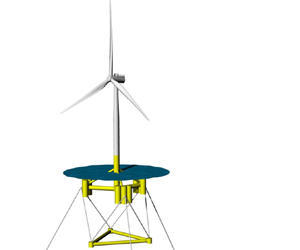Article contents
Wave- and drag-driven subharmonic responses of a floating wind turbine
Published online by Cambridge University Press: 27 October 2021
Abstract

The nonlinear hydrodynamic responses of a novel spar-type soft-moored floating offshore wind turbine are investigated via analysis of motion measurements from a wave-basin campaign. A prototype of the TetraSpar floater, supporting a  $1:60$ scale model of the DTU 10 MW reference wind turbine, was subjected to irregular wave forcing (with no wind) and shown to exhibit subharmonic resonant motions, which greatly exceeded the wave-frequency motions. These slow-drift responses are excited nonlinearly, since the rigid-body natural frequencies of the system lie below the incident-wave frequency range. Pitch motion is examined in detail, allowing for identification of different hydrodynamic forcing mechanisms. The resonant response is found to contain odd-harmonic components, in addition to the even harmonics expected a priori and excited by second-order difference-frequency hydrodynamic interactions. Data analysis utilising harmonic separation and signal conditioning suggests that Morison drag excitation or third-order subharmonic potential flow forcing could be at play. In the extreme survival-conditions sea state, the odd resonant responses are identified to be drag-driven. Their importance for the tested floater is appreciable, as their magnitude is comparable to the second-order potential flow effects. Under such severe conditions, the turbine would not be operating, and as such neglecting aerodynamic forcing and motion damping is likely to be reasonable. Additionally, other possible drivers of the resonant pitch response are explored. Both Mathieu-type parametric excitation and wavemaker-driven second-order error waves are found to have negligible influence. However, we note slight contamination of the measurements arising from wave-basin sloshing.
$1:60$ scale model of the DTU 10 MW reference wind turbine, was subjected to irregular wave forcing (with no wind) and shown to exhibit subharmonic resonant motions, which greatly exceeded the wave-frequency motions. These slow-drift responses are excited nonlinearly, since the rigid-body natural frequencies of the system lie below the incident-wave frequency range. Pitch motion is examined in detail, allowing for identification of different hydrodynamic forcing mechanisms. The resonant response is found to contain odd-harmonic components, in addition to the even harmonics expected a priori and excited by second-order difference-frequency hydrodynamic interactions. Data analysis utilising harmonic separation and signal conditioning suggests that Morison drag excitation or third-order subharmonic potential flow forcing could be at play. In the extreme survival-conditions sea state, the odd resonant responses are identified to be drag-driven. Their importance for the tested floater is appreciable, as their magnitude is comparable to the second-order potential flow effects. Under such severe conditions, the turbine would not be operating, and as such neglecting aerodynamic forcing and motion damping is likely to be reasonable. Additionally, other possible drivers of the resonant pitch response are explored. Both Mathieu-type parametric excitation and wavemaker-driven second-order error waves are found to have negligible influence. However, we note slight contamination of the measurements arising from wave-basin sloshing.
JFM classification
- Type
- JFM Papers
- Information
- Copyright
- © The Author(s), 2021. Published by Cambridge University Press
References
REFERENCES
- 16
- Cited by



